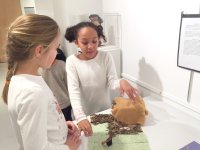Bringing Social Studies to Life With PBL
A teacher transforms her third-grade unit on Native Americans into a semester-long project-based learning unit.
Your content has been saved!
Go to My Saved Content.This generation of students presents a unique challenge to educators: How can schools continue to engage and teach children who have access to so much knowledge at their fingertips? How can we join school programs and curriculum with student interests and passions when much of their learning is occurring outside the walls of the classroom?
The answer is complicated, but for me it lies in the relationship among student agency, project-based learning (PBL), and the power of student voice and choice in their learning.
Bringing PBL to Social Studies in the Early Grades
In the third-grade social studies curriculum at Friends School of Baltimore, where I teach, what used to be a mundane, teacher-led unit on Native Americans is now a semester-long PBL unit. We start by addressing stereotypes of Native Americans and the debate over Native American team mascots because, in the end, we want our students to be motivated to educate their community about breaking these stereotypes.
First we unpack the concept of stereotypes through deep discussion, and the students reflect on that learning by creating posters with phrases like: “Just because I am a boy doesn’t mean I can’t have long hair” and “Just because I am a girl doesn’t mean I can’t play football.” Suddenly their eyes are opened, and everything around them is a stereotype.
We then show our students current images of Native American mascots of sports teams. They watch interviews with Native Americans about the mascots and hear the Washington Redskins’ owner defend the team’s name. We ask the third graders to address this question: Should sports teams be allowed to use Native American names and mascots?
After researching both sides of the issue, the third graders form strong opinions of their own. We use this opportunity to teach persuasive paragraph writing, and when they finish their paragraphs, they want to have a debate, which leads to lessons on the fundamentals of formal debate.
This front-loading is essential in engaging students, and now, after about a month of preparation, they’re ready to hear the driving question that we will use to build a mini-museum: How can we as museum curators teach our community about Native American culture in the past and in the present?
In order to create our museum, we do extensive research over the course of about three weeks. Each child focuses on a different tribe. They read books, use graphic organizers to practice note-taking skills, and settle on one idea they want to teach to the community. Students are engaged and excited about beading Sioux clothing, building a Cherokee winter house, and making Wampanoag weapons.
In addition to our research with books, we’re lucky enough to be able to visit the National Museum of the American Indian in Washington, DC. Our third graders are there not just to visit and look around but also to note how Native American history is exhibited. They return home with designs and plans in their heads.
The students create a plan for their project with accurate blueprints, and list all materials needed and explain their process in writing. Then they begin to gather materials to build their exhibits. They plan to address questions such as: “How would I build a Hopi bow and arrow?” “How can I show the beliefs of the Huron about death?” “I want to weave blankets for my Wetu because that is how they built the houses.”
Not every student achieves success at every point. I watch as many a clay structure crumbles because a student doesn’t heed the advice of an art teacher. I see frustration in the eyes of partners who don’t share the responsibilities of building a project.
The students suffer natural consequences throughout the process, and assessment is based on collaboration, creativity, communication, and flexibility. Learning and assessment for each child are about the process, not the product.
Exhibits begin to take shape: a Nez Perce fishing trap, a woven Hopi blanket, and more.
After working to design and build their exhibits for about two weeks, the students write an artist’s statement about the process and materials they used to create their exhibit, as well as a paragraph about the tribe as it exists today. These paragraphs, along with their persuasive paragraphs about using Native American names and mascots for sports teams from the beginning of the project, allow for cross-curricular teaching of important writing skills.
Finally we have the museum opening, and each student stands near his or her exhibit to explain to the visitors what the exhibit represents and how it was created. The museum is open for a week, during which time parents, faculty, and administrators learn about Native American life in the past and in the present. The lower grades come to view the museum at prearranged times. In this way, our students experience an authentic audience for their learning, and they can thank themselves for their success.
